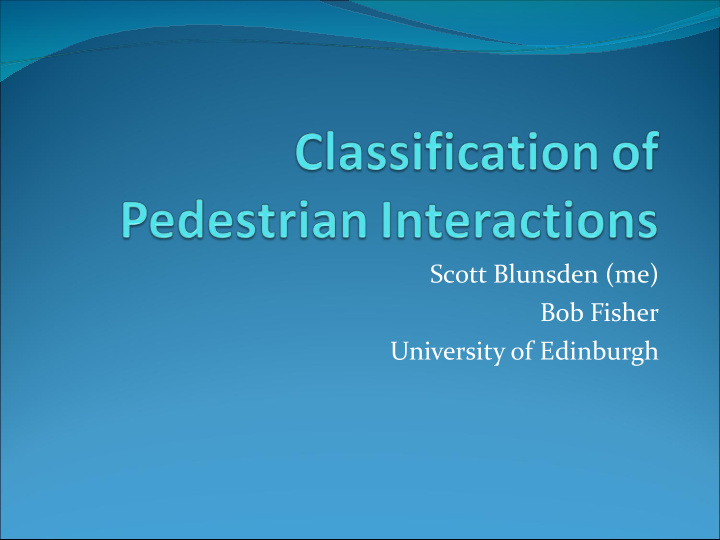



Scott Blunsden (me) Bob Fisher University of Edinburgh
What is this talk about? Considerations for metrics Present results, show considerations. Evaluations should give a good idea of the expected performance.
Main focus will be around the Edinburgh Dataset (see Bob’s talk)
Plan Show you how we do classification. Then discuss issues surrounding how to evaluate it.
Classification Have sequences which are labelled. Sequence labelled as a fight or people walking together. Divide sequences up into a training and testing set 50- 50 split. (Show Video)
Classification (2) Assume that Tracking can be done reasonably well Features which are calculated Speed of an individual time t Alignment of two people (dot product) Distance between people Change in distance between people at time t and t-w Difference in speed Difference between the difference in position at time t and time t-w (are they getting nearer or further away) Difference between starting positions (for an observed amount of time) We use PCA to reduce the dimensionality
Now for the results part I can get my method to classify 97.93 % correct But what should I expect if I actually run this method ? And how useful is this statistic anyway? (Show video)
What we really would like to know How well is this method doing How can we tell What are the main variables Focus on the data from the video information here, not the model (although it is related).
What aspects of the data make the most difference? Ontology What things are called how they are defined. What is a behaviour ? How do we define a fight? a meeting? Here it is done by example (eg the labelled sequences define what we mean). Vocabularies may differ depending upon the user. What happened in the video depends upon what you were looking for. Check Assumptions (make them available)
The Data itself No pre-defined test/training set? Should show error bars over multi runs. Eg we took the best result, fine but what performance should I expect if I were to repeat this experiment. Agreed test set. However you really want to know how well a method can be expected to perform. What's the expected performance? Confusion matrix and priors. Per class performance is important. Frequent classes may dominate.
Some results Classification using a Conditional Random Field. Classify the pre-labelled sequences from the dataset. Results are per frame: mean: 96.03 min: 93.8 max: 97.93 var: 2.79
Confusion Matrix In Group Approach Walk Split Ignore Fight Run Chase Together Together 43197 0 0 33 0 172 0 0 68 3450 0 140 0 0 0 0 71 0 5030 286 0 313 0 0 0 0 0 2870 0 180 0 0 0 236 10 0 289 0 0 0 177 0 0 176 0 1514 0 0 0 0 0 0 0 0 422 11 0 0 0 0 0 0 65 35
Time
Time (2) There is a bound Upper limit on how good accuracy can be given the amount of time you watch a sequence. There is a point where you can do no better. The longer the sequence the less examples you have for training.
Time (3) – Results - Single Run
Time (4) – Results – Multi Run
Things to consider Accessibility Open and accessible data and labelling (others can check your assumptions). Consideration to training and testing sets. Expected performance (rather than best). Bounds on information available (hard to determine but can be reported).
Recommend
More recommend